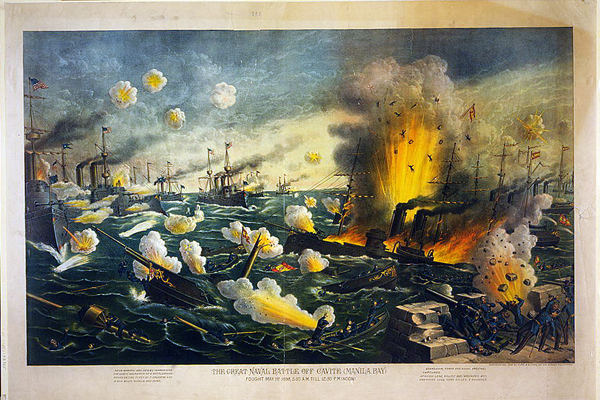
Battle of Manila Bay, May 1, 1898.
On May 1, 1898, Admiral Dewey's flotilla reached Manila Bay and engaged the obsolecent Spanish Fleet off of the Spanish
naval base of Cavite on the southern part of Manila Bay. The naval base was on a tidal island off the main
part of the provence of Cavite. The Town of San Roque connected to naval base by a
single wagon way or causeway. The wagon road would flood at high tide much in the same manner as the causeway from
Penzance to St. Michael's Mount in Cornwall or its counter-part in Normandy, France, Mont Saint Michel. St. Michael's Mount is
known to many school children as the
place where during the reign of King Arthur, Jack the Giant Killer saved the people of the
area from the Giant. Additionally, The Cavite wagon road was impassible during the rainy season. During such times it
was necessary to use a boat or ferry. The rainy season in the area is from June to November, the dry season from
December to May.
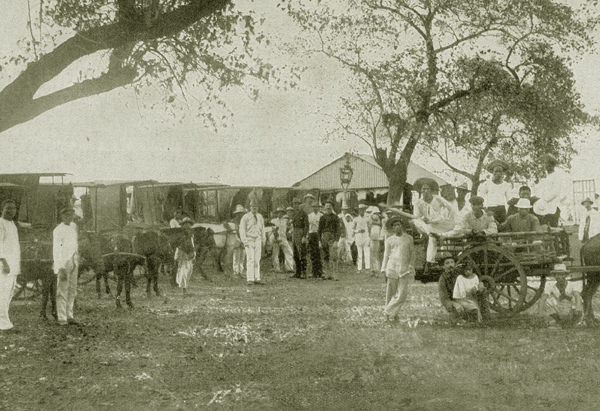
Waiting for the Cavite-San Roque Ferry, 1898.
Dewey remained out of reach of shore batteries. One Spanish vessel, the CASTILLA, had guns only on the port side. She, in addition, had engine problems and had to be
towed to the scene of the battle and moored. Part of her mooring lines were hit by
American fire allowing the currents to swing her
around so that she presented only her starboard side to the Americans. The Spanish flagship REINA CRISTINA unsuccessfully attempted to ram
OLYMPIA and made it shoreward where she was scuttled. The remaining Spanish vessels were put out of action. A bombardment of the Spanish magazine at
Cavite blew it up. With the victory over the Spanish fleet, Dewey was yet unable to occupy Manila itself. He was 7,000 miles from home and there were no
friendly ports available. Thus, it became necessary to occupy Cavite until American troops arrived.
In addition to the distance, Dewey was hampered by a lack of communication with Washington. At first, Dewey suggested to Spanish officials that they jointly use the telegraph
line. The Spanish Governor-General refused to allow the telegraph company to transmit Dewey's messages.
Dewey cut the cable and therefore neither had any communicatons. Messages were then required to be carried by
ship to Hong Kong and from there telegraphed back to the United States. At the time, practially all international cmmmunication was through a web of underwater cables going to and from
Porthcunno, Cornwall. The system was designed to tie the far flung British Empire together. Communication from London to India, as an example, took only four minuted. The fact that the center of the world's communications
was in an obscure village in Cornwall as later discussed, had great significance during World War I. See Company C, Wyoming National Guard Goes to War.
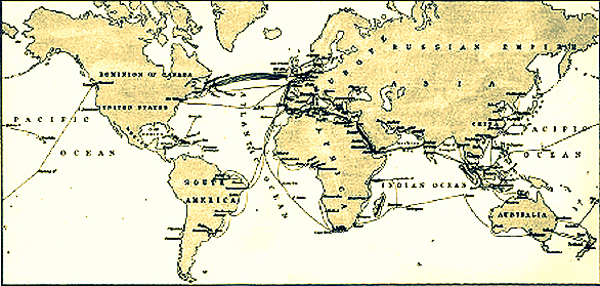
Map of the World's oceanic telegraph lines, 1903.
While the lack of communication delayed things for Admiral Dewey, it was devasting for the Spanish. They might hope that the Spanish
home fleet under Rear Admiral Camara might come to the rescue through Suez. The Fleet only made it as far as
Suez when on July 7, the Spanish government fearing an American attack on
Spain itself, recalled Admiral Camara to Spain. Water supply, as noted by Richard H. Titherington in his "A History of the Spanish-American War of 1899,"
D. Appleton and Company, New York, 1900, at p. 373, water supply to the city had been cut off, the only food was that already stored in the City. Titherington wrote,
"The Philippine capital was practically taken when Dewey destroyed Montojo's squandron on the morning of May 1st."
The plight of the Spanish in the Manila might be likened to the Argentines in the Falklands
as the their troops heard in the distance the sound of
bagpipes and fear of the Brigade of Gurkhas which has served the British Crown for more than two hundred years. The Spanish were stuck with no relief just as the
Argentines were stuck in the Falklands.
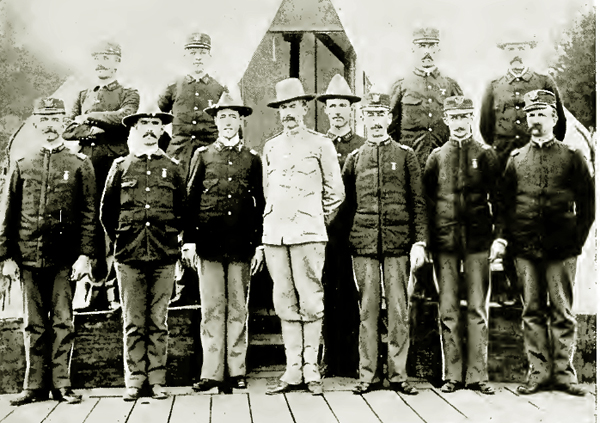
First Wyoming Voluneers, San Francisco, May, 1898.
In the meantime Wyoming National Guard troops were at Camp Richards. On May 18 the troops left the Camp and proceeded to the
Capitol where they were mustered into Federal Service and were introduced to Governor Richards. They then
marched to the Union Pacific Depot and left for San Francisco.
They were accompanied by Governor Richards who stayed with them until
they embarked for the Philippines on June 27 on the transport ship OHIO. Just as the Torrey's Rough Riders were presented with
care packages as they left Cheyenne, the National Guard was presented by the ladies at each stop across Wyoming.
In Laramie Lieutenant Harol D. Coburn (1873-1944) was presented with an officers sword.
In San Francisco the Army was in a state of unreadiness. With the Wyoming and other troops expected
shortly General Elwell Stephen Otis on May 18th complained to Washington:
The * * * [CITY OF PEKIN and CITY OF SYDNEY] * * * should be ready to load on Saturday. Galleys and bunks should be complete on Friday.
The Australia should be ready for troops on Monday. These vessels can not
carry any quartermaster's transportation (ani¬mals and wagons). Will have
these vessels inspected to ascertain if seaworthy and in good sanitary
condition. Their carrying capacity when crowded will not be over 175
officers and 2,500 men, independent of Navy contingent which goes on
Pekin. Plans of all decks of these vessels will be furnished me as soon
as carrying arrangements completed. No other vessels suitable for the
transportation of troops can be secured by Government at present.
Those sailing from this port are the Ohio, the Senator, the China, the
Colon, the St Paul, the Columbia, and State of California. The Ohio is en route for Seattle,
and advertised to leave that port for Alaska June 15.
The Senator, St, Paul, Columbia, and State of California can
not be chartered; available only by seizure. The China, from Hong¬kong,
will reach this port about June 2 and the Colon, from Panama,
about May 24; the Conemaugh, not suited for troops but adapted for animals and freight, now en route to Seattle. Any of these vessels if secured must be put in condition for troop transportation, and it is doubtful if troops could be sent in them from this port in less time than four weeks, present absence of vessels considered. The Pekin is to take on eighty odd officers and men of Navy and a large tonnage of naval stores, etc., and doubtful if more than single full regiment of troops of army can be safely transported. Vessel has made no provision for messing officers and will not unless high rate stipulated for and money guaranty. Troops present and intended for embarkation are band and four companies Fourteenth Infantry (9 officers and 276 men), two regiments and two battalions of California infantry (thirty-four companies in all), two companies of California heavy artillery, giv¬ing for California nearly 8,000 officers and men. First Oregon Regiment, twelve companies, arrived this afternoon. A regiment from Minnesota, Nebraska, Kansas, Colorado, each, and the Wyoming battalion will arrive on or before the 20th instant. None of the troops are properly equipped, but a few can be made avail¬able for service in distant country with means at hand. Articles of ordnance, tentage, and light clothing especially needed. Some of the California troops have old .50-caliber Springfield muskets. I have not assumed command here of incom¬ing troops in obedience to my orders of the 12th instant, and I am at a loss to understand that it is the intention of the authorities that I, with staff and not to exceed an infantry regiment of untrained troops, proceed to the Philippines and occupy such parts of the islands as I may be able until other troops are sent to that distant point. I might be of service in putting the troops here in condition. I
request immediate instructions.
OTIS, Major-Oeneral of Volunteers.
See Correspondence Relating to the War with Spain, 1898-1902 By United States. Adjutant-General's Office.
Notwithstanding, the impending arrival of the Wyoming National Guard troops, tents to house the soldiers were not ready. After arrival at
Camp Merritt in San Fransciso, it was several days before tents were ready. In the
meantime it rained and the troops had to camp in barns, sheds or out in the open.
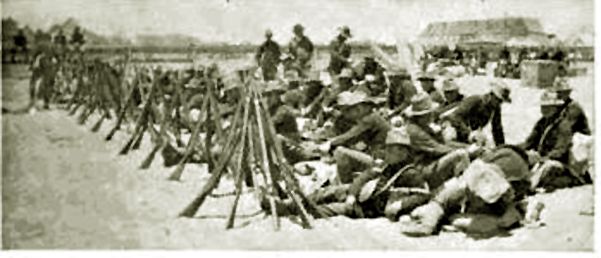
First Wyoming Voluneers, waiting for tents. San Francisco, May, 1898.
Conditions on the vessels were terrible. Joseph deBurgh in his 1939 "A Few Reminiscences of
the First Expedition of American Troops to Manila",
The American Oldtimer. Vol VI, No. 6. April 1939, 23-29, Vol VII,
No. 1. Pioneers Club of Manila, November 1939, 26-30, 45-48
commented as to the CITY OF SIDNEY:
The fleet of transports which had been provided by the Federal Government to carry the First Expedition to Manila was composed of old cattle ships.
I cannot speak about the condition of the other ships composing
the fleet as I did not go aboard any of them but the S. S. City of
Sidney the one on which my company and six other companies of the regiment
together with five Companies of the Fourteenth Infantry and Battery "A"
heavy artillery of San Francisco embarked was an awful thing to be placed
in service as a transport to carry a thousand men on a voyage of eight
thousand miles. Not even having been fumigated before we embarked it was
terribly lousy and filthy. Right up to the day we arrived in Manila Bay
we were kept busy sweeping up horse manure and other filth that had
accumulated for years. The toilet and bathing facilities to accommodate
the large number of men on board were totally inadequate. No
refrigerating plant for the preservation of fresh meats and vegetables
had been installed. The bunks for the use of the troops were built in
between decks in tiers, six bunks to the tier. There was a space of two
feet between bunks. Each one was supplied with a thin mattress and pillow
stuffed with excelsior.
Other Wyoming troops left on the CITY OF PUEBLA and arrived on August 21. A part of the Wyoming Light Artillery left San Francisco on
the NEWPORT on November 8 and arrived on December 7, 1898.
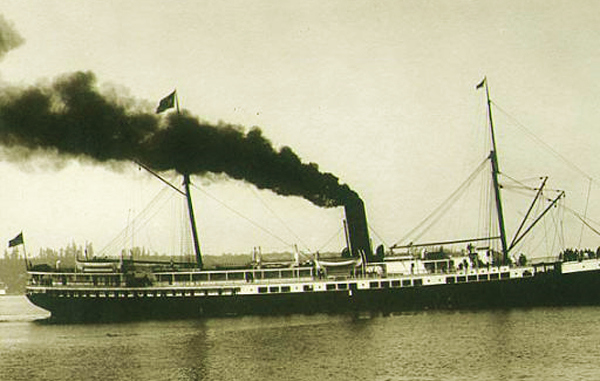
CITY OF PUEBLA.
The Army scrounged around the west coast for ships which it could charter. A total of twenty-two
ships were chartered including one sailing ship. The
OHIO on which the first Wyoming troops sailed, as an example, was constructed in 1872 for the emigrant trade between Liverpool and Philadelphia. It was one of the first
American Flag merchant ships to enter service after the Civil War. During the Civil War, the Confederate Navy basically drove
American merchant vessels from the seas. The OHIO'S passenger manifests typically showed about
125-135 passengers in steerage, about 12 in Second Cabin and 15 in Saloon for a total, excluding crew, of about 150. After a brief stint in the Southhamption-Philadelphia tread,
in 1898, she was moved to the West Coast for service in
the Yukon Gold Rush. The Army crammed into the OHIO, excluding crew, 24 oficers and 886 men. The troops were transported to the Philippines in multliple
convoys or "expeditions." The tranports leaving on the 27th were a part of the
third expedition. The Wyoming Light Brigade was part of the fourth expedition which arrived on August 21. Following the trip to
Manila, the OHIO returned to the Yukon trade. In 1907, it hit an iceberg but did not sink. A number of panicked passenger leaped off the ship into the frigid waters and died.
The captain beached the vessel Which was repaired and put back into service. Two years later it hit an
uncharted rock in Briish Columbia and was lost. The rock is now known as "Ohio Rock."
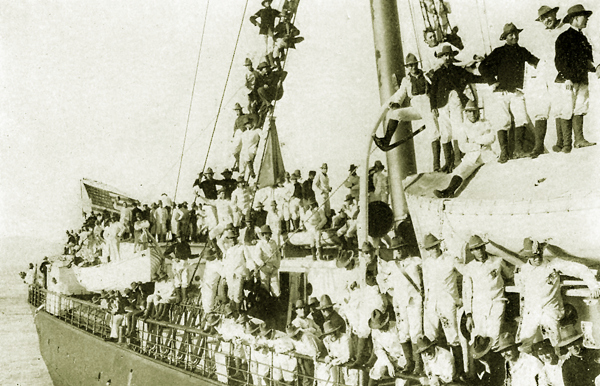
The OHIO leaving San Francisco, June 17, 1898.
The vessels were infested with lice. George Steunenberg of the 1st Idaho wrote of his experiences on the
MORGAN CITY:
[T]here was no salt water soap to be had for washing clothes, and as a result
the men became infected with myriads of “soldiers’ friends”[lice] from
which there was no relief. However, they accepted the situation philosophically, even cheerfully, and one man in particular created an immense amount of amusement. He would select two big graybacks designated as “Miles” and “Blanco,” put an army at the back of each, and then enjoy a bird’s eye view of the battle, for they would actually attack each other with all the hatred of Yankees and Spaniards.
We know little of the state of affairs on the other ships, as we travel
a mile apart, but one day a straw mattress that had been thrown overboard
from the INDIANA came floating by, and our men declared that it was
covered with graybacks [lice] that were standing up singing, “Life on the Ocean
Wave.” On another occasion we came within hailing distance of the OHIO,
and a chorus of voices from her decks shouted, “Come over and help us
scratch.”
Most of the vessels being former freighters were distinctly short of water closets. In the ward room on some ships, officers ate fresh beef
(Some ships carried cattle sufficient to satisfy the needs of the officers) and freshly baked bread. Below decks, the
troops below dined on hardtack, tinned "willie," a substance in World War I referred to as
"monkey meat," and tinned tomatoes. De Burgh wrote as to the food the one thing they missed was fresh bread:
"The one thing that we all longed for more than anything else was fresh
bread and in order to get it some of us even went so far as to steal
it from the oven in the officers' galley. A crowd of men could always be
seen in front of the galley door when bread was being baked for the
officers' mess. They could at least enjoy the smell of its baking.
This, however, only drove them to recklessness and when the baker had his
back turned some one would sneak in the galley and snatch a loaf from the
oven. It was not long until the baker got wise and reported it to the
mess officer. From then on there was always a sentry posted at the galley
door on baking days.
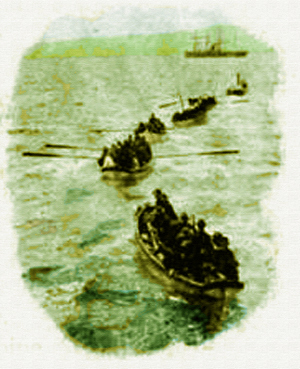 "lighters being towed and rowed to shore, Manila" artwork by G. B. Dobson based on a photograph.
"lighters being towed and rowed to shore, Manila" artwork by G. B. Dobson based on a photograph.
For the most part, the various expeditions from San Francisco to Manila were uneventful. Faust, maybe to reassure his readers,
noted that the Americans were in the lap of luxury as compared to the Royal Navy. He claimed that in
the Royal Navy a berth was allocated 70 to 77 cubic feet of air. In the United States Army the allotment
was 80 to 100 cubic feet. In his book Faust displayed a photograph of the racks of bunks on the SHERMAN. Photograph may have been
misleading or as a result of reliance on interviews with Army commanders who wished to soft
peddle complaints about the troop transports.
The SHERMAN was a former cattle boat constructed by Harland & Wolf who later constructed the
R.M.S. Titanic. With the inability to charter sufficient ships to transfer troop, the Army bought the SHERMAN from its previous
British Owners in 1899 and in New York converted it to a troop ship. Although the SHERMAN was used to bring troops back from
the Philippines, it was not in service at the time of the convoys from San Francisco.
While there may have been bunks
on some American ships, the use of hammocks was
not eliminated in the U.S. Navy until the 1930's and World War II. The "Gray Funnel Line," to which the Royal Navy was sometimes referred,
phased out hammocks by the time of the
Korean War. The voyages to Manila were, however, replete with disease and
"discomfort." They were not like "crossings" on either the White Star Line or Cunard even if one was travelling
steerage. Faust wrote:
Few can realize the conditions at the time that the first expedition cast anchor in Manila Bay.
With the best that could be done, it was impossible, in the hurried
departure from the States, and the many hindrances unavoidable in securing transports, to properly equip and supply the troops.
As a consequence, the members of the first expedition endured many
discomforts which were largely avoided in the subsequent expeditions. The germs of disease, which soon after landing became
widespread and alarming, were undoubtedly fostered on board the transports. The 2nd Oregon were the worst sufferers.
It was reported that within thirty days after debarkation, not more than
one-half of the regiment was fit for camp duties. There was much complaint on shipboard of improper food supply and clothing, and shoes were not up to the standard. Hygienic conditions aboard ship were doubtless neglected. The change from civil to military life brings new and untried conditions, which usually put to the test the best physical conditions. Add to this climatic change, improper diet and bad sanitation, and many break down under the strain. As the transport and supply service became better organ¬ized, and the troops got under better discipline, these conditions
gradually disappeared.
Faust noted that the
the most prevalent disease, especially in the second expedition, was measles. From Wyoming Morley L. Hassard died from cerebro-spinal meningitis, Charles Wilseck from Typhoid.
At least the Royal Navy did not have the prevelence of disease thanks to the "daily tot"
distributed at six bells a mixture of water, sugar, lime juice, and 1/2 gill of rum (Imperial), in other words, a highly spiked
limeade. The daily tot was eliminated in the Royal Navy on July 31, 1970, a day which will forever go down in infamy as
"Black Tot Day." The daily tot was eliminated in the Royal Canadian Navy in 1972 and the Royal New Sealand Navy in February 1990.
On special occasions such as the centennial of the Canadian Royal Navy or the Queen's Diamond Jubilee, the daily tot may still be distributed..
The United States Navy eliminated grog about 1860.
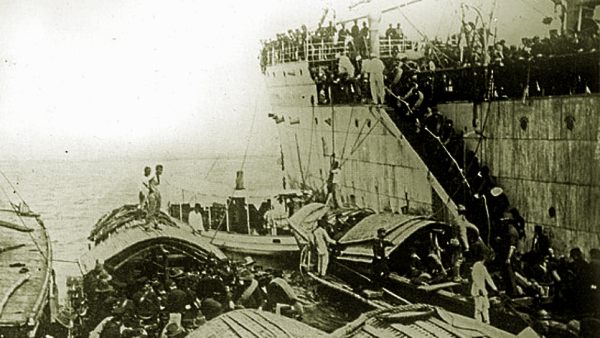
Debarking on "cascos."
Debarkment from the OHIO and other transport ships was by means of lighters called "cascos" which had to be towed to shore.
Karl Irving Faust (1868-1935) in his Campaigning in the Philippines, Hicks-Judd Company, San Francisco, 1899, described the lighters as
"a kind of hybrid affair, unwieldy and cumbersome, without sail or steam; neither Chinese junk nor American scow, but partaking of the
characteristics of both. They are built of heavy timbers, with outlying riggers and towed from one position to another."
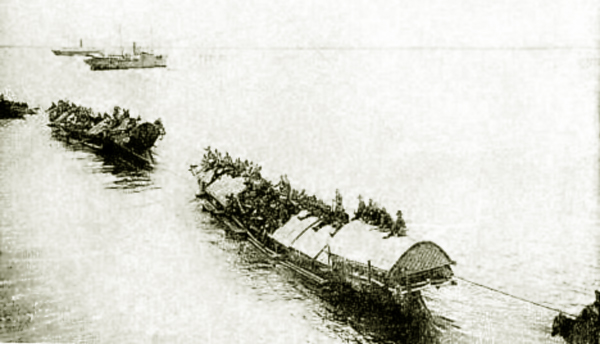
Heading to shore from the Newport on "cascos."
When the men of the First Wyoming was being towed to shore, one of the cascos in which Lt. Coburn was riding capsized. He lost the sword with which he was presented in
Laramie.
When the men of the First Wyoming was being towed to shore, one of the cascos in which Lt. Coburn was riding capsized. He lost the sword with which he was presented in
Laramie.
The OHIO arrived at Manila Bay on July 31 but did not debark until the next week. They
encamped at Paranagua later known as "Camp Dewey." Part of the reason for the delay in disembarkment was heavy seas as a result of
a tropical storm which hit on the evening of July 31. The soil in which trenches had been
constructed, according to Titherington, "was so wet that it could be held in place only by bagging
it, and the mud so deep that shoes were ruined and many men perforce went barefoot. One storm left two feet of water in part of the
trenches." The tropical storm had am impact on other operations. First Wyoming participated in the actual entry into
Manila after the city surrendered. They remained there and Manila until transferred to
Cavite on January 2, 1889.
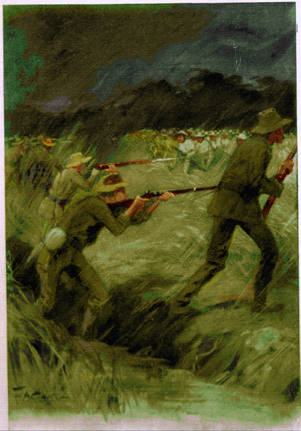 "Battle in the Rain," artwork by G. B. Dobson based on a drawing by Fernando A. Carter.
"Battle in the Rain," artwork by G. B. Dobson based on a drawing by Fernando A. Carter.
Carter (1855-1931) at the time was a well known illustrator and later was the director of the
Syracuse Museum of Fine Arts.
The Wyoming troops were assigned by General Order No. 2 along with the 23rd U.S. Infantry, the 14th U.S. Infantry, Minnesota,
and Idaho, and North Dakota Volunteers
to the First Brigade under General Arthur MacArthur, the father of Douglas MacArthur.
American troop were already occupying trenches fronting trenches occupied by
Spanish troops while negotiations ensued. Because of the delays in arrival and debarking, the Wyoming
Infantry missed the first land engagement known as the "Battle in the Rain."
The "battle" was a totally useless and unneeded engagement. Pensylvania troops manning
trenches opposite Spanish troops believed that in the storm the Spanish were attempting to outflank
their positon. Faust, p. 89, described the battle:
On the night of July 31st, however, the tension reached a climax, and
there occurred between the forces what is known as the " Battle in the Rain."
It was one of those typical tropical night storms in which there was
a raging wind and a furious downpour, and, in the darkness, objects
were not discernible beyond your reach. In the rush and roar of
the storm you could neither see nor hear. It was certainly a reckless
enthusiasm which could drive our soldiers out on such a night against
orders and at the hazard of their lives. Exactly what occurred when
the conflict was at its height would be difficult to learn. At the time
it was supposed and believed, and the order of the command so stated,
that the Spaniards had left their trenches and attempted to turn our
right flank. It is now conceded this was not so, and the Spaniards,
after their surrender of Manila, said they never left their trenches.
Music this Page:
A Life on the Ocean Wave
(original lyrics below)
Music by Henry Russell
As played and sung by Fred Feild
A life on the ocean wave! A home on the rolling deep!
Where the scattered waters rave, and the winds their revels keep!
A life on the ocean wave! A home on the rolling deep!
Where the scattered waters rave, and the winds their revels keep!
Like an eagle caged I pine, on this dull unchanging shore.
Oh give me the flashing brine! The spray and the tempest roar!
A life on the ocean wave! A home on the rolling deep!
Where the scattered waters rave, and the winds their revels keep!
The winds, the winds, the winds their revels keep!
The winds, the winds, the winds their revels keep!
But with a stout vessel and crew we'll say let the storm come down!
The land is no longer in view, the clouds have begun to frown
But with a stout vessel and crew we'll say let the storm come down!
And the song of our hearts shall be, while the winds and waters rave.
A life on the heaving sea! A home on the bounding wave!
A life on the ocean wave! A home on the rolling deep!
Where the scattered waters rave, and the winds their revels keep!
The winds, the winds, the winds their revels keep!
The winds, the winds, the winds their revels keep!
The song has been adopted by the Royal Marines as its regimental quick march and is the
official march of the United States Merchant Marine Acadamy.
Next page: Wyoming National Guard in Cavite.
|